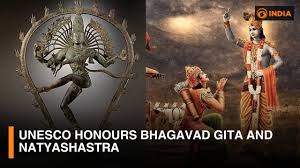
Global Honour for India: Bhagavad Gita and Natyashastra Included in UNESCO’s Memory of the World Register
Global Honour for India: Bhagavad Gita and Natyashastra Included in UNESCO’s Memory of the World Register
India’s deep cultural roots and intellectual legacy have once again gained global appreciation. Two iconic Indian texts—the Bhagavad Gita and Bharat Muni’s Natyashastra—were officially added to UNESCO’s Memory of the World Register. These timeless works are now part of a carefully curated list of 570 documentary heritage items from around the world, recognised for their historical, cultural, or social value.
This year, UNESCO accepted 74 new entries from 72 countries and four international organisations, marking a significant expansion of the register. These additions cover a wide range of themes—from scientific discoveries and peace-building efforts to the role of women in shaping history. Among them, the Gita and Natyashastra stand tall as enduring symbols of India’s philosophical depth and creative brilliance.
A Moment of National Pride
Responding to the inclusion of these works, Indian Prime Minister Narendra Modi described it as “a proud moment for every Indian around the globe.” In a message shared on X (formerly Twitter), he reflected on the eternal relevance of these ancient texts, stating that they have “enriched human understanding for generations” and continue to inspire people in every corner of the world.
Union Minister for Culture, Gajendra Singh Shekhawat, also took to social media to mark the occasion. Calling it a “historic recognition of India’s civilisational wisdom,” he emphasized that these literary masterpieces go beyond intellectual merit—they have helped shape the Indian worldview, from spiritual beliefs to artistic expression. With this milestone, India now boasts 14 entries on the UNESCO register.
Bhagavad Gita: A Universal Guide for Inner and Outer Life
The Bhagavad Gita, found within the epic Mahabharata, is a sacred dialogue between Prince Arjuna and Lord Krishna, exploring fundamental questions of life, duty, and morality. Composed over 2,000 years ago, it blends spiritual insight with philosophical reasoning and has left a lasting impression on spiritual thinkers, leaders, and scholars worldwide.
Its teachings revolve around timeless principles—such as selfless action, the nature of reality, and inner discipline. More than just a religious scripture, the Gita has become a guiding light for those seeking clarity in complex moral situations. Its presence on UNESCO’s list recognises its global impact and the wisdom it continues to offer across generations and cultures.
Natyashastra: Blueprint of Indian Performing Arts
While the Gita speaks to the soul’s journey, Natyashastra is a profound exploration of human expression through art. Attributed to sage Bharatmuni and believed to be written around 2nd century BCE, this foundational work outlines the principles of drama, dance, and music in extraordinary detail.
It is more than just a manual—it’s a philosophical framework that explores how emotions are evoked through performance. The idea of Rasa, or the aesthetic flavor experienced by the audience, originates from this text and continues to influence Indian art forms such as Bharatanatyam, Kathak, Odissi, and more. UNESCO’s recognition of Natyashastra acknowledges its role as one of the oldest and most comprehensive guides to the performing arts in world history.
What is the Memory of the World Register?
The Memory of the World Register is a global initiative launched by UNESCO to preserve and promote significant documentary materials that have shaped human knowledge and culture. Since its establishment in 1992, it has grown into an important platform for recognising rare manuscripts, archives, and historical records.
This year’s newly added entries reflect a diverse range of topics, from technological advances of the Scientific Revolution to crucial diplomatic milestones. A notable feature of the 2025 selections is the spotlight on the often-underrepresented role of women throughout history—a welcome step toward balanced documentation of the human story.
India’s Expanding Footprint in Global Heritage
With the inclusion of the Gita and Natyashastra, India’s representation in the register grows to 14, reaffirming the nation’s deep civilisational continuity. Other Indian entries include Vedic texts and colonial archives that showcase the subcontinent’s layered past. These inclusions serve not only as cultural achievements but also as diplomatic tools that enhance India’s presence on the global heritage map.
Such recognitions contribute to strengthening India's "soft power"—a nation's ability to influence others through cultural richness and intellectual appeal rather than economic or military strength. They also underline India's role as a guardian of knowledge systems that have stood the test of time.
Beyond Archives: Living Traditions That Still Inspire
The inscription of these two ancient works into the Memory of the World Register isn't simply about preservation. These are not forgotten relics of the past—they are living traditions. The Gita continues to be studied in spiritual circles and academic institutions alike, while the principles of Natyashastra still inform stage performances, film theory, and artistic training.
In today’s world, where rapid change often disconnects us from our roots, these works offer something rare—timeless wisdom, enduring relevance, and a roadmap for conscious living and expression. Their preservation ensures that future generations have access not just to India’s past, but to its enduring contribution to global thought and culture.
Conclusion: A Heritage Beyond Borders
The addition of Bhagavad Gita and Natyashastra to the UNESCO register is more than symbolic—it is a powerful affirmation of India’s civilisational essence. These works are not confined to a particular religion, region, or era. They speak to all of humanity—about how to act with integrity, how to create with purpose, and how to live with awareness.
As India celebrates this international honour, the message is clear: heritage is not just what we inherit—it’s what we continue to uphold and share with the world. The Gita and Natyashastra, now recognised by a global institution, remind us of the universal value of ancient wisdom, and the responsibility we all share in keeping it alive.